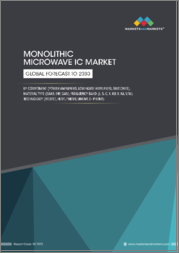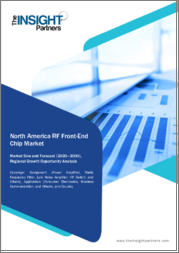
|
시장보고서
상품코드
1772359
파워앰프 시장 규모, 점유율, 동향 분석 보고서 : 유형별, 용도별, 지역별, 부문 예측(2025-2030년)Power Amplifier Market Size, Share & Trends Analysis Report By Type (Audio-Power, Radio-Power), By Application (Smartphone, Tablets, PCs, Laptops, Audio Equipment), By Region, And Segment Forecasts, 2025 - 2030 |
||||||
파워앰프 시장의 성장과 동향 :
Grand View Research, Inc.의 최신 보고서에 따르면, 세계 전력 증폭기 시장 규모는 2030년에 754억 5,000만 달러에 달하고, 2025-2030년 연평균 13.1%를 보일 것으로 예측됩니다.
무선 통신 기술의 급증, 5G 인프라 구축, 고성능 오디오 및 데이터 전송 시스템에 대한 소비자 수요 증가는 시장 성장을 가속화하는 주요 요인입니다. 전력 증폭기는 스마트폰, 커넥티드 디바이스, 차량용 전자제품, 산업 시스템 등의 신호 강도와 품질을 향상시키는 데 중요한 역할을 합니다. 고속 네트워크와 커넥티드 에코시스템의 확산은 효율적이고 컴팩트한 고주파 전력 증폭기에 대한 수요를 더욱 증가시키고 있습니다.
질화갈륨(GaN), 탄화규소(SiC) 등 첨단 반도체 기술의 통합으로 전력 증폭기의 성능 향상, 고효율화, 저발열화, 광대역화가 가능해졌습니다. 이러한 기술 혁신은 레이더 시스템, 위성 통신, IoT 기기 등 차세대 용도에 필수적입니다. 또한, 스마트폰, 태블릿, 무선 오디오 기기 등의 기기에서 실감나는 오디오와 끊김 없는 연결성에 대한 기대가 높아짐에 따라 제조업체들은 첨단 증폭기 모듈을 채택하고 있으며, 가전기기 부문은 계속해서 큰 기여를 하고 있습니다.
국내 반도체 생산에 대한 정부의 지원과 미국, 중국, 한국 등 주요 시장에서 5G 인프라에 대한 투자가 증가하면서 시장 전망이 더욱 밝아지고 있습니다. 구독 기반 및 모듈형 증폭기 시스템도 특히 통신 및 국방 분야에서 인기를 얻고 있으며, 확장 가능하고 비용 효율적인 솔루션을 제공합니다. 디지털 신호 처리와 AI 기반 네트워크 최적화로의 전환은 증폭기 설계를 변화시켜 보다 스마트하고 적응력이 뛰어난 RF 시스템을 위한 길을 열어주고 있습니다.
설계의 복잡성, 열 관리 문제, 공급망 불안정성 등의 과제는 여전히 남아 있지만, 대역폭, 데이터 속도, 에너지 효율적인 통신 솔루션에 대한 수요가 가속화되면서 채택을 촉진하고 있습니다. 북미는 기술 혁신과 배포에서 시장을 선도하고 있으며, 아시아태평양은 제조 및 가전제품 수요를 주도하고 있습니다. 중동 및 아프리카 등 신흥 지역은 특히 모바일 연결과 국방 현대화 분야에서 새로운 성장 기회를 제공합니다.
전력 증폭기 시장 하이라이트
- 유형별로는 오디오 파워앰프가 2024년 62.25%의 매출 점유율로 시장을 장악했습니다. 이는 특히 TV, 무선 스피커, 홈시어터 시스템과 같은 기기에 고품질 사운드 성능을 제공하기 위해 가전제품에 널리 사용되고 있기 때문입니다. 저전력 오디오 신호를 강력한 출력으로 변환하는 효율성으로 인해 최신 오디오 용도에서 중요한 구성 요소로 자리 잡았습니다.
- 용도별로는 스마트폰 부문이 2024년 54.01%로 가장 큰 매출 점유율을 차지했습니다. 신흥국을 중심으로 스마트폰의 보급이 급증하고 있으며, 고품질 오디오 경험을 원하는 소비자 수요와 맞물려 제조업체들은 첨단 파워앰프 기술 통합을 추진하고 있습니다. 이러한 추세는 모바일 기기의 다기능화 및 오디오 중심화가 진행됨에 따라 지속될 것으로 예측됩니다.
- 지역별로는 아시아태평양이 전력 증폭기 시장의 지배적인 지역으로 2024년 45% 이상의 매출 점유율을 차지했습니다. 이러한 성장의 원동력은 중국, 인도, 일본, 한국 등의 국가에서 가전제품의 급속한 발전, 스마트폰의 보급 확대, 자동차 및 산업 부문의 확대에 기인합니다. 이 지역의 강력한 제조거점과 고성능 오디오 및 통신 장비에 대한 수요 증가는 시장 확대에 박차를 가하고 있습니다.
목차
제1장 조사 방법과 범위
제2장 주요 요약
제3장 시장 변수, 동향, 범위
- 세계의 파워앰프 시장 전망
- 업계 밸류체인 분석
- 판매채널 분석
- 기술 개요
- 규제 프레임워크
- 시장 역학
- 시장 성장 촉진요인 분석
- 시장 성장 억제요인 분석
- 시장 기회 분석
- 시장이 해결해야 할 과제
- Porter의 Five Forces 분석
- 공급 기업의 교섭력
- 바이어의 교섭력
- 대체 위협
- 신규 진출업체의 위협
- 경쟁 기업간 경쟁 관계
- PESTLE 분석
- 정치적
- 경제
- 사회 상황
- 테크놀러지
- 환경
- 법률상
제4장 파워앰프 시장 : 유형별 추정·동향 분석
- 파워앰프 시장 : 유형 변동 분석, 2024년 및 2030년
- 오디오 파워
- 무선 전력
제5장 파워앰프 시장 : 용도별 추정·동향 분석
- 파워앰프 시장 : 용도 변동 분석, 2024년 및 2030년
- 스마트폰
- 태블릿
- PC
- 노트북
- 오디오 기기
제6장 파워앰프 시장 : 지역별 추정·동향 분석
- 지역 분석, 2024년과 2030년
- 북미
- 유형별, 2018년-2030년
- 용도별, 2018년-2030년
- 미국
- 캐나다
- 멕시코
- 유럽
- 유형별, 2018년-2030년
- 용도별, 2018년-2030년
- 독일
- 스페인
- 영국
- 프랑스
- 러시아
- 이탈리아
- 아시아태평양
- 유형별, 2018년-2030년
- 용도별, 2018년-2030년
- 중국
- 인도
- 일본
- 호주
- 라틴아메리카
- 유형별, 2018년-2030년
- 용도별, 2018년-2030년
- 브라질
- 아르헨티나
- 중동 및 아프리카
- 유형별, 2018년-2030년
- 용도별, 2018년-2030년
- 사우디아라비아
- 남아프리카공화국
- 아랍에미리트(UAE)
제7장 경쟁 구도
- 주요 시장 진출기업의 최근 동향과 영향 분석
- 기업 분류
- 히트맵 분석
- 벤더 구도
- 기기 공급업체 리스트
- 유통업체 리스트
- List of prospective end-users
- Strategy Initiatives by Typers
- 기업 개요/상장기업
- Infineon Technologies
- Texas Instruments
- Broadcom
- Toshiba
- STMicroelectronics
- Maxim Integrated
- Yamaha Corporation
- Qorvo
- NXP Semiconductors
- Analog Devices
Power Amplifier Market Growth & Trends:
The global power amplifier market size is projected to reach USD 75.45 billion by 2030 and is expected to grow at a CAGR of 13.1% from 2025 to 2030, according to a new report by Grand View Research, Inc. The surge in wireless communication technologies, 5G infrastructure rollout, and rising consumer demand for high-performance audio and data transmission systems are key drivers accelerating market growth. Power amplifiers are critical in boosting signal strength and quality across smartphones, connected devices, automotive electronics, and industrial systems. The proliferation of high-speed networks and connected ecosystems further increases the demand for efficient, compact, high-frequency power amplifiers.
Rising integration of advanced semiconductor technologies such as gallium nitride (GaN) and silicon carbide (SiC) enhances power amplifier performance, enabling higher efficiency, lower heat generation, and broader bandwidth support. These innovations are essential for next-generation applications, including radar systems, satellite communications, and IoT devices. Additionally, the consumer electronics sector continues to be a major contributor, with manufacturers adopting advanced amplifier modules to meet growing expectations for immersive audio and seamless connectivity in devices such as smartphones, tablets, and wireless audio equipment.
Government support for domestic semiconductor production and increasing investments in 5G infrastructure across key markets like the U.S., China, and South Korea further strengthen the market outlook. Subscription-based and modular amplifier systems are also gaining traction, especially in telecom and defense applications, offering scalable and cost-effective solutions. The shift toward digital signal processing and AI-driven network optimization transforms amplifier design, paving the way for smarter, more adaptive RF systems.
Although challenges such as high design complexity, thermal management issues, and supply chain volatility persist, the accelerating demand for bandwidth, data speed, and energy-efficient communication solutions continues to drive adoption. North America leads the market in innovation and deployment, while Asia-Pacific dominates manufacturing and consumer electronics demand. Emerging regions like the Middle East and Africa present new growth opportunities, especially in mobile connectivity and defense modernization efforts.
Power Amplifier Market Report Highlights:
- Based on type, audio power amplifiers dominated the market with a revenue share of 62.25% in 2024 due to their widespread use in consumer electronics, especially in delivering high-quality sound performance across devices such as televisions, wireless speakers, and home theater systems. Their efficiency in converting low-power audio signals into powerful outputs makes them a critical component in modern audio applications.
- Based on application, the smartphone segment held the largest revenue share of 54.01% in 2024. The surge in smartphone adoption, particularly in emerging economies, coupled with consumer demand for high-quality audio experiences, has driven manufacturers to integrate advanced power amplifier technologies. This trend is expected to sustain as mobile devices become more multifunctional and audio-centric.
- Based on region, Asia Pacific is the dominant region in the power amplifier market, and accounted for a revenue share of over 45% in 2024. This growth is driven by rapid advancements in consumer electronics, increasing smartphone penetration, and expanding automotive and industrial sectors in countries like China, India, Japan, and South Korea. The region's strong manufacturing base and growing demand for high-performance audio and communication devices continue to fuel market expansion
Table of Contents
Chapter 1. Methodology and Scope
- 1.1. Market Segmentation & Scope
- 1.2. Market Definition
- 1.3. Information Procurement
- 1.3.1. Information Analysis
- 1.3.2. Data Analysis Models
- 1.3.3. Market Formulation & Data Visualization
- 1.3.4. Data Validation & Publishing
- 1.4. Research Scope and Assumptions
- 1.4.1. List of Data Sources
Chapter 2. Executive Summary
- 2.1. Market Outlook
- 2.2. Segmental Outlook
- 2.3. Competitive Outlook
Chapter 3. Market Variables, Trends, and Scope
- 3.1. Global Power Amplifier Market Outlook
- 3.2. Industry Value Chain Analysis
- 3.2.1. Sales Channel Analysis
- 3.3. Technology Overview
- 3.4. Regulatory Framework
- 3.5. Market Dynamics
- 3.5.1. Market Driver Analysis
- 3.5.2. Market Restraint Analysis
- 3.5.3. Market Opportunity Analysis
- 3.5.4. Market Challenges
- 3.6. Porter's Five Forces Analysis
- 3.6.1. Bargaining Power of Suppliers
- 3.6.2. Bargaining Power of Buyers
- 3.6.3. Threat of Substitution
- 3.6.4. Threat of New Entrants
- 3.6.5. Competitive Rivalry
- 3.7. PESTLE Analysis
- 3.7.1. Political
- 3.7.2. Economic
- 3.7.3. Social Landscape
- 3.7.4. Technology
- 3.7.5. Environmental
- 3.7.6. Legal
Chapter 4. Power Amplifier Market: Type Estimates & Trend Analysis
- 4.1. Power Amplifier Market: Type Movement Analysis, 2024 & 2030
- 4.2. Audio-Power
- 4.2.1. Market estimates and forecasts, 2018 - 2030 (USD Million)
- 4.3. Radio-Power
- 4.3.1. Market estimates and forecasts, 2018 - 2030 (USD Million)
Chapter 5. Power Amplifier Market: Application Estimates & Trend Analysis
- 5.1. Power Amplifier Market: Application Movement Analysis, 2024 & 2030
- 5.2. Smartphone
- 5.2.1. Market estimates and forecasts, 2018 - 2030 (USD Million)
- 5.3. Tablets
- 5.3.1. Market estimates and forecasts, 2018 - 2030 (USD Million)
- 5.4. PCs
- 5.4.1. Market estimates and forecasts, 2018 - 2030 (USD Million)
- 5.5. Laptops
- 5.5.1. Market estimates and forecasts, 2018 - 2030 (USD Million)
- 5.6. Audio Equipment Market estimates and forecasts, 2018 - 2030 (USD Million)
Chapter 6. Power Amplifier Market: Regional Estimates & Trend Analysis
- 6.1. Regional Analysis, 2024 & 2030
- 6.2. North America
- 6.2.1. Market estimates and forecasts, 2018 - 2030 (USD Million)
- 6.2.2. Market estimates and forecasts, by type, 2018 - 2030 (USD Million)
- 6.2.3. Market estimates and forecasts, by application, 2018 - 2030 (USD Million)
- 6.2.4. U.S.
- 6.2.4.1. Market estimates and forecasts, 2018 - 2030 (USD Million)
- 6.2.4.2. Market estimates and forecasts, by type, 2018 - 2030 (USD Million)
- 6.2.4.3. Market estimates and forecasts, by application, 2018 - 2030 (USD Million)
- 6.2.5. Canada
- 6.2.5.1. Market estimates and forecasts, 2018 - 2030 (USD Million)
- 6.2.5.2. Market estimates and forecasts, by type, 2018 - 2030 (USD Million)
- 6.2.5.3. Market estimates and forecasts, by application, 2018 - 2030 (USD Million)
- 6.2.6. Mexico
- 6.2.6.1. Market estimates and forecasts, 2018 - 2030 (USD Million)
- 6.2.6.2. Market estimates and forecasts, by type, 2018 - 2030 (USD Million)
- 6.2.6.3. Market estimates and forecasts, by application, 2018 - 2030 (USD Million)
- 6.3. Europe
- 6.3.1. Market estimates and forecasts, 2018 - 2030 (USD Million)
- 6.3.2. Market estimates and forecasts, by type, 2018 - 2030 (USD Million)
- 6.3.3. Market estimates and forecasts, by application, 2018 - 2030 (USD Million)
- 6.3.4. Germany
- 6.3.4.1. Market estimates and forecasts, 2018 - 2030 (USD Million)
- 6.3.4.2. Market estimates and forecasts, by type, 2018 - 2030 (USD Million)
- 6.3.4.3. Market estimates and forecasts, by application, 2018 - 2030 (USD Million)
- 6.3.5. Spain
- 6.3.5.1. Market estimates and forecasts, 2018 - 2030 (USD Million)
- 6.3.5.2. Market estimates and forecasts, by type, 2018 - 2030 (USD Million)
- 6.3.5.3. Market estimates and forecasts, by application, 2018 - 2030 (USD Million)
- 6.3.6. UK
- 6.3.6.1. Market estimates and forecasts, 2018 - 2030 (USD Million)
- 6.3.6.2. Market estimates and forecasts, by type, 2018 - 2030 (USD Million)
- 6.3.6.3. Market estimates and forecasts, by application, 2018 - 2030 (USD Million)
- 6.3.7. France
- 6.3.7.1. Market estimates and forecasts, 2018 - 2030 (USD Million)
- 6.3.7.2. Market estimates and forecasts, by type, 2018 - 2030 (USD Million)
- 6.3.7.3. Market estimates and forecasts, by application, 2018 - 2030 (USD Million)
- 6.3.8. Russia
- 6.3.8.1. Market estimates and forecasts, 2018 - 2030 (USD Million)
- 6.3.8.2. Market estimates and forecasts, by type, 2018 - 2030 (USD Million)
- 6.3.8.3. Market estimates and forecasts, by application, 2018 - 2030 (USD Million)
- 6.3.9. Italy
- 6.3.9.1. Market estimates and forecasts, 2018 - 2030 (USD Million)
- 6.3.9.2. Market estimates and forecasts, by type, 2018 - 2030 (USD Million)
- 6.3.9.3. Market estimates and forecasts, by application, 2018 - 2030 (USD Million)
- 6.4. Asia Pacific
- 6.4.1. Market estimates and forecasts, 2018 - 2030 (USD Million)
- 6.4.2. Market estimates and forecasts, by type, 2018 - 2030 (USD Million)
- 6.4.3. Market estimates and forecasts, by application, 2018 - 2030 (USD Million)
- 6.4.4. China
- 6.4.4.1. Market estimates and forecasts, by type, 2018 - 2030 (USD Million)
- 6.4.4.2. Market estimates and forecasts, by application, 2018 - 2030 (USD Million)
- 6.4.5. India
- 6.4.5.1. Market estimates and forecasts, by type, 2018 - 2030 (USD Million)
- 6.4.5.2. Market estimates and forecasts, by application, 2018 - 2030 (USD Million)
- 6.4.6. Japan
- 6.4.6.1. Market estimates and forecasts, by type, 2018 - 2030 (USD Million)
- 6.4.6.2. Market estimates and forecasts, by application, 2018 - 2030 (USD Million)
- 6.4.7. Australia
- 6.4.7.1. Market estimates and forecasts, by type, 2018 - 2030 (USD Million)
- 6.4.7.2. Market estimates and forecasts, by application, 2018 - 2030 (USD Million)
- 6.5. Latin America
- 6.5.1. Market estimates and forecasts, 2018 - 2030 (USD Million)
- 6.5.2. Market estimates and forecasts, by type, 2018 - 2030 (USD Million)
- 6.5.3. Market estimates and forecasts, by application, 2018 - 2030 (USD Million)
- 6.5.4. Brazil
- 6.5.4.1. Market estimates and forecasts, by type, 2018 - 2030 (USD Million)
- 6.5.4.2. Market estimates and forecasts, by application, 2018 - 2030 (USD Million)
- 6.5.5. Argentina
- 6.5.5.1. Market estimates and forecasts, by type, 2018 - 2030 (USD Million)
- 6.5.5.2. Market estimates and forecasts, by application, 2018 - 2030 (USD Million)
- 6.6. Middle East & Africa
- 6.6.1. Market estimates and forecasts, 2018 - 2030 (USD Million)
- 6.6.2. Market estimates and forecasts, by type, 2018 - 2030 (USD Million)
- 6.6.3. Market estimates and forecasts, by application, 2018 - 2030 (USD Million)
- 6.6.4. Saudi Arabia
- 6.6.4.1. Market estimates and forecasts, by type, 2018 - 2030 (USD Million)
- 6.6.4.2. Market estimates and forecasts, by application, 2018 - 2030 (USD Million)
- 6.6.5. South Africa
- 6.6.5.1. Market estimates and forecasts, by type, 2018 - 2030 (USD Million)
- 6.6.5.2. Market estimates and forecasts, by application, 2018 - 2030 (USD Million)
- 6.6.6. UAE
- 6.6.6.1. Market estimates and forecasts, by type, 2018 - 2030 (USD Million)
- 6.6.6.2. Market estimates and forecasts, by application, 2018 - 2030 (USD Million)
Chapter 7. Competitive Landscape
- 7.1. Recent Developments & Impact Analysis, By Key Market Participants
- 7.2. Company Categorization
- 7.3. Heat Map Analysis
- 7.4. Vendor Landscape
- 7.4.1. List of equipment suppliers
- 7.4.2. List of distributors
- 7.5. List of prospective end-users
- 7.6. Strategy Initiatives by Typers
- 7.7. Company Profiles/Listing
- 7.7.1. Infineon Technologies
- 7.7.1.1. Company Overview
- 7.7.1.2. Financial Performance
- 7.7.1.3. Type Benchmarking
- 7.7.2. Texas Instruments
- 7.7.2.1. Company Overview
- 7.7.2.2. Financial Performance
- 7.7.2.3. Type Benchmarking
- 7.7.3. Broadcom
- 7.7.3.1. Company Overview
- 7.7.3.2. Financial Performance
- 7.7.3.3. Type Benchmarking
- 7.7.4. Toshiba
- 7.7.4.1. Company Overview
- 7.7.4.2. Financial Performance
- 7.7.4.3. Type Benchmarking
- 7.7.5. STMicroelectronics
- 7.7.5.1. Company Overview
- 7.7.5.2. Financial Performance
- 7.7.5.3. Type Benchmarking
- 7.7.6. Maxim Integrated
- 7.7.6.1. Company Overview
- 7.7.6.2. Financial Performance
- 7.7.6.3. Type Benchmarking
- 7.7.7. Yamaha Corporation
- 7.7.7.1. Company Overview
- 7.7.7.2. Financial Performance
- 7.7.7.3. Type Benchmarking
- 7.7.8. Qorvo
- 7.7.8.1. Company Overview
- 7.7.8.2. Financial Performance
- 7.7.8.3. Type Benchmarking
- 7.7.9. NXP Semiconductors
- 7.7.9.1. Company Overview
- 7.7.9.2. Financial Performance
- 7.7.9.3. Type Benchmarking
- 7.7.10. Analog Devices
- 7.7.10.1. Company Overview
- 7.7.10.2. Financial Performance
- 7.7.10.3. Type Benchmarking
- 7.7.1. Infineon Technologies
(주말 및 공휴일 제외)


















